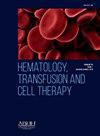LOW DOSE CYTARABINE PLUS SORAFENIB IN AN ELDERLY PATIENT WITH ACUTE MYELOID LEUKEMIA
IF 1.6
Q3 HEMATOLOGY
引用次数: 0
Abstract
Introduction
Acute Myeloid Leukemia (AML) is the most common acute leukemia in adults and is generally associated with a poor prognosis. The failure of therapeutic approaches in AML treatment is attributed to various clinical characteristics of patients, disease biology, and treatment intensity. Mutations in the Fms-Like Tyrosine kinase-3 (FLT3) receptor have been reported in approximately one-third of AML cases. The most common FLT3 mutation is Internal Tandem Duplication (ITD), which has been identified in approximately 25% of adult AML patients and in 3%–5% of newly diagnosed Myelodysplastic Syndromes (MDS). FLT3-ITD is associated with high White Blood Cell (WBC) counts, elevated Lactate Dehydrogenase (LDH) levels, increased percentages of blast cells in the blood and bone marrow, and poor clinical outcomes. However, it does not appear to significantly affect the ability of adult patients to achieve Complete Remission (CR).
Objective
This case report presents the response of a 71-year-old AML patient to low-dose Cytarabine (Ara-C) combined with sorafenib treatment.
Case presentation
A 71-year-old female patient presented in February 2024 with complaints of excessive thirst, fatigue, weakness, and loss of appetite. At diagnosis, leukocytosis, anemia, and thrombocytopenia were observed. Peripheral blood smear analysis revealed blast cell infiltration, and immunophenotypic studies identified markers consistent with the AML M5 subtype: CD34+/− (3.4%), CD123+, CD33+, CD13+, CD14+, CD36+, CD64+, HLA-DR+, and cMPO+. Conventional karyotyping was normal, whereas molecular analysis detected FLT3-ITD (51%, 27 bp mutant). Given the patient’s overall health status, a treatment regimen of low-dose Ara-C (20 mg BID on days 1–10) and sorafenib (400 mg on days 11–28) was initiated. Due to hematologic toxicity, dose reductions were necessary during treatment. After four cycles, bone marrow aspiration revealed a blast percentage of 0.8%, FLT3-ITD mutation was no longer detectable, and Minimal Residual Disease (MRD) negativity was achieved, confirming Complete Remission (CR). This treatment protocol was selected based on the patient's clinical condition, leading to a successful outcome.
Results
FLT3-ITD-positive AML patients may benefit from low-dose Ara-C and sorafenib therapy, particularly when carefully selected based on clinical criteria. However, further comprehensive randomized prospective studies are required to better evaluate the efficacy and safety of this approach.
Discussion
This case highlights the efficacy of low-dose cytarabine and sorafenib combination therapy in an elderly AML patient with FLT3-ITD mutation. FLT3-ITD mutation is a well-established marker of poor prognosis in AML and is associated with resistance to conventional therapies. In elderly AML patients, treatment decisions are often challenging due to comorbidities and reduced tolerance to intensive chemotherapy. The standard approach for geriatric AML patients includes hypomethylating agents combined with BCL-2 inhibitors, with the addition of FLT3 inhibitors when indicated. However, given the patient’s high frailty index, a decision was made to initiate low dose cytarabine and sorafenib therapy, resulting in complete remission and MRD negativity. It is important to note that hematologic toxicity may require dose adjustments during treatment, as observed in this case. Macdonald et al. conducted a Phase I/II study in 21 patients with MDS and AML, reporting a complete response rate of only 10% with low dose cytarabine and sorafenib therapy. Although this outcome may seem discouraging, our case demonstrates that this combination remains a viable option for selected elderly AML patients with FLT3-ITD who are ineligible for intensive chemotherapy. Nevertheless, larger scale randomized controlled trials are necessary to further assess the efficacy and safety of this treatment approach. In the future, investigating the combination of this regimen with other targeted agents, such as venetoclax, may expand treatment options. Additionally, long-term follow-up data and quality-of-life assessments will be essential to understanding the real-world effectiveness of this therapeutic strategy.
低剂量阿糖胞苷加索拉非尼治疗老年急性髓性白血病1例
急性髓系白血病(AML)是成人中最常见的急性白血病,通常预后较差。AML治疗方法的失败归因于患者的各种临床特征、疾病生物学和治疗强度。据报道,大约三分之一的AML病例中存在fms样酪氨酸激酶-3 (FLT3)受体突变。最常见的FLT3突变是内部串联重复(ITD),已在大约25%的成年AML患者和3%-5%的新诊断骨髓增生异常综合征(MDS)中发现。FLT3-ITD与白细胞(WBC)计数高、乳酸脱氢酶(LDH)水平升高、血液和骨髓中母细胞百分比增加以及临床预后差有关。然而,它似乎并没有显著影响成年患者达到完全缓解(CR)的能力。目的报告1例71岁急性髓性白血病患者对低剂量阿糖胞苷(Ara-C)联合索拉非尼治疗的反应。71岁女性患者,于2024年2月就诊,主诉过度口渴、疲劳、虚弱、食欲不振。诊断时,观察到白细胞增多、贫血和血小板减少。外周血涂片分析显示母细胞浸润,免疫表型研究鉴定出与AML M5亚型一致的标志物:CD34+/−(3.4%)、CD123+、CD33+、CD13+、CD14+、CD36+、CD64+、HLA-DR+和cMPO+。常规核型分析正常,而分子分析检测到FLT3-ITD (51%, 27 bp突变)。考虑到患者的整体健康状况,开始了低剂量Ara-C (BID 20 mg,第1-10天)和索拉非尼(400 mg,第11-28天)的治疗方案。由于血液毒性,在治疗期间必须减少剂量。4个周期后,骨髓穿刺显示blast百分比为0.8%,FLT3-ITD突变不再检测到,最小残留病(MRD)阴性,确认完全缓解(CR)。这种治疗方案是根据患者的临床情况选择的,导致了一个成功的结果。flt3 - itd阳性AML患者可能受益于低剂量Ara-C和索拉非尼治疗,特别是在根据临床标准仔细选择时。然而,需要进一步的全面随机前瞻性研究来更好地评估该方法的有效性和安全性。本病例强调了低剂量阿糖胞苷和索拉非尼联合治疗老年AML患者FLT3-ITD突变的疗效。FLT3-ITD突变是AML预后不良的一个公认的标志,并与对常规治疗的耐药性有关。在老年AML患者中,由于合并症和对强化化疗的耐受性降低,治疗决策往往具有挑战性。老年AML患者的标准方法包括低甲基化药物联合BCL-2抑制剂,并在适应症时添加FLT3抑制剂。然而,鉴于患者的高脆弱指数,决定开始低剂量阿糖胞苷和索拉非尼治疗,导致完全缓解和MRD阴性。值得注意的是,血液学毒性可能需要在治疗期间调整剂量,正如本病例所观察到的那样。Macdonald等人对21例MDS合并AML患者进行了一项I/II期研究,报告低剂量阿糖胞苷和索拉非尼治疗的完全缓解率仅为10%。尽管这一结果似乎令人沮丧,但我们的病例表明,对于不适合接受强化化疗的FLT3-ITD老年AML患者,这种联合治疗仍然是一种可行的选择。然而,需要更大规模的随机对照试验来进一步评估这种治疗方法的有效性和安全性。在未来,研究该方案与其他靶向药物(如venetoclax)的联合,可能会扩大治疗选择。此外,长期随访数据和生活质量评估对于了解这种治疗策略的实际有效性至关重要。
本文章由计算机程序翻译,如有差异,请以英文原文为准。
求助全文
约1分钟内获得全文
求助全文
来源期刊

Hematology, Transfusion and Cell Therapy
Multiple-
CiteScore
2.40
自引率
4.80%
发文量
1419
审稿时长
30 weeks
 求助内容:
求助内容: 应助结果提醒方式:
应助结果提醒方式:


